The Conversation
June 25, 2023,

(AFP Photo/Torsten Blackwood)
LONG READ
The Arctic’s climate is warming at least four times faster than the global average, causing irrevocable changes to this vast landscape and precarious ecosystem – from the anticipated extinction of polar bears to the appearance of killer whales in ever-greater numbers. A new study suggests the Arctic Ocean could be ice-free in summer as soon as the 2030s – around a decade earlier than previously predicted.

A new Arctic sea ice map compares the 30-year average with recent ten-year averages.
British Antarctic Survey
But to properly understand the pace and force of what’s to come, we should instead focus on organisms too small to be seen with the naked eye. These single-celled microbes are both the watchkeepers and arch-agitators of the Arctic’s demise.
Scientists like me who study them have become forensic pathologists, processing crime scenes in our Arctic field sites. We don the same white anti-contamination suits, photograph each sampling site, and bag our samples for DNA analysis. In some areas, red-coloured microbes even create an effect known as “blood snow”.
In this complex criminal investigation, however, the invisible witnesses are also responsible for the damage being done. Microbes testify to the vulnerability of their Arctic habitats to the changes that humans have caused. But they also create powerful climate feedback loops that are doing ever-more damage both to the Arctic, and the planet as a whole.
Zipping headlong into icy oblivion
My first visit to the Arctic was also nearly my last. As a PhD student in my early 20s in 2006, I had set out with colleagues to sample microbes growing on a glacier in the Norwegian archipelago of Svalbard – the planet’s northernmost year-round settlement, about 760 miles from the North Pole.
Our treacherous commute took us high above the glacier, traversing an icy scree slope to approach its flank before crossing a river at the ice’s margin. It was a route we had navigated recently – yet this day I mis-stepped. Time slowed as I slid towards the stream swollen with ice melt, my axe bouncing uselessly off the glassy ice. I was zipping headlong into icy oblivion.
In that near-death calm, two things bothered me. The water would carry me deep into the glacier, so it would be decades before my remains were returned to my family. And the ear-worm of that field season meant I would die to the theme tune to Indiana Jones.
Thankfully, the scree slowed my slide – I lived and learned, quickly, that dead scientists don’t get to write up their papers. And I’m still learning about the tiny organisms that populate every habitat there: from seawater in the Arctic Ocean to ice crystals buried deep in the Greenland ice sheet.
These micro-managers of all manner of planetary processes are acutely sensitive to the temperatures of their habitats. The slightest change above freezing can transform an Arctic landscape from a frozen waste devoid of liquid water to one where microbes get busy reproducing in nutrient-rich water, transforming themselves in ways that further amplify the effects of climate warming.
The Svalbard region is now warming seven times faster than the global average. While much of the world continues its efforts to limit global warming to 1.5°C above pre-industrial levels, in the Arctic, that battle was lost long ago.
Joseph Cook’s film on the microbes that inhabit the Greenland ice sheet.
Decades ahead of us all
It’s 2011, and Nozomu Takeuchi is visiting Svalbard from Japan. It has been a difficult year back home, following the earthquake, tsunami and Fukushima nuclear incident, but Nozomu – a glacier ecologist and professor at Chiba University – is unrelenting in his quest to measure the effects of climate change.
Just hours after he stepped off a plane in the August midnight sun at Longyearbyen airport, we are marching up the nearest glacier. Above us, snow-capped mountain sides loom out of the swirling mist.
Since the 1990s, Nozomu has been collecting samples and measurements from glaciers all over the world. When we reach our goal near the snowline, he opens his rucksack to reveal a bento box full of sampling kit – stainless steel scoops, test tubes, sample bags, all arranged for efficiency. As he scurries around with practised efficiency, I think of offering help but fear I would only slow him down.
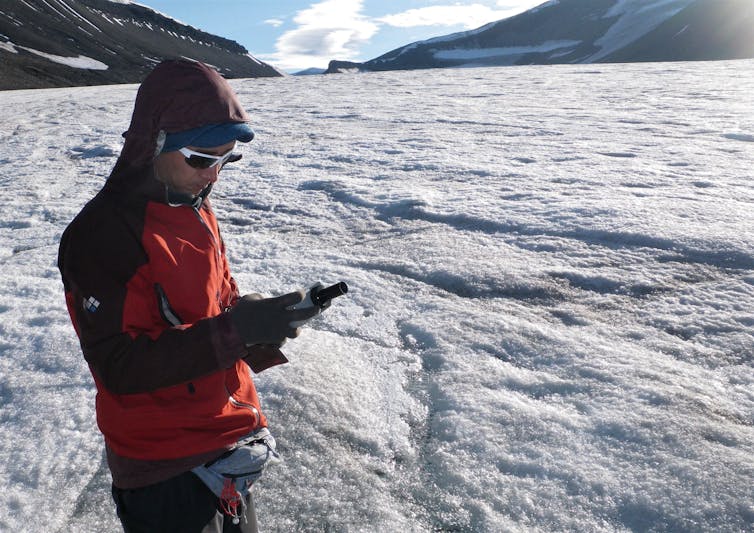
Nozomu Takeuchi measuring the biological darkening of a Svalbard glacier in 2011.
Arwyn Edwards, Author provided
In truth, Nozomu is decades ahead of us all. Years ago, he made the link between the future of life and the death of ice, and these melting Svalbard glaciers are adding yet more points to his graphs.
Just as we apply oodles of factor 50 to protect ourselves from the Sun, so the billions of microbes sandwiched between the sky and surface of the glacier protect themselves by accumulating sunscreen-like pigments. And if enough of these pigments rest in one place under the Sun, this area of “biological darkening” absorbs the heat of the Sun much more effectively than reflective white snow and ice – so it melts faster.
Nozomu scoops up some of the so-called blood snow, heavily laden with algae. Under the microscope, their cells are indeed reminiscent of red blood cells. But rather than haemoglobin, these cells are laden with carotenoids – pigments also found in vegetables that protect the algae from overheating. Other patches of the glacier are verdant green, rich in algae that are busy photosynthesising light into chemical energy in this 24-hour daylight world.
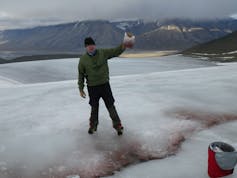
The author with a sample of ‘blood snow’, collected from a glacier surface.
Arwyn Edwards, Author provided
Further down the glacier, the professor crushes some “dirty” ice into a bag. A different kind of algae lives here that, depending on your point-of-view, is either black, brown or purple (perhaps it depends on the tint of your sunglasses). The pigment created is like the compounds that colour tea, and the algae keep it in layers like parasols above the photosynthetic factories within their cells – ensuring they have just enough sunlight to photosynthesise, but not enough to burn.
Open Google Earth and as you zoom in on the Arctic, you may spot the large dark stripe that scars the western margin of the Greenland ice sheet. This is the “dark zone”, but it’s not caused by dark dust or soot. It’s alive, laden with algae – and it has been darkening, and growing, as Greenland warms.
Between 2000 and 2014, the dark zone’s area grew by 14%. At 279,075 km² in 2012, it was already more than twice the size of England than bare ice.
Next morning, I am woken by the smell of chemicals, having slept beneath a coffee table. Nozomu is busy processing his samples: bags of melting ice pinned to a clothesline by bulldog clips. They resemble bunting around the crowded room, but this is no time for celebration. The tint of each bag adds a measurement which quantifies the link between these algae, their pigments, and the death of their icy home.
The case becomes urgent
By the summer of 2014, glaciologists all over the world have started to listen to the warnings of pioneering ecologists such as Nozomu. The glaciers are dying even as life blossoms on their darkening surfaces. The case has become urgent.
I am in a helicopter, flying with colleagues to a camp in the dark zone on the Greenland ice sheet – the largest mass of glacial ice in the northern hemisphere. Covering 1.7 million km², its ice holds the equivalent of the water required to raise global sea levels by 7.7 metres.
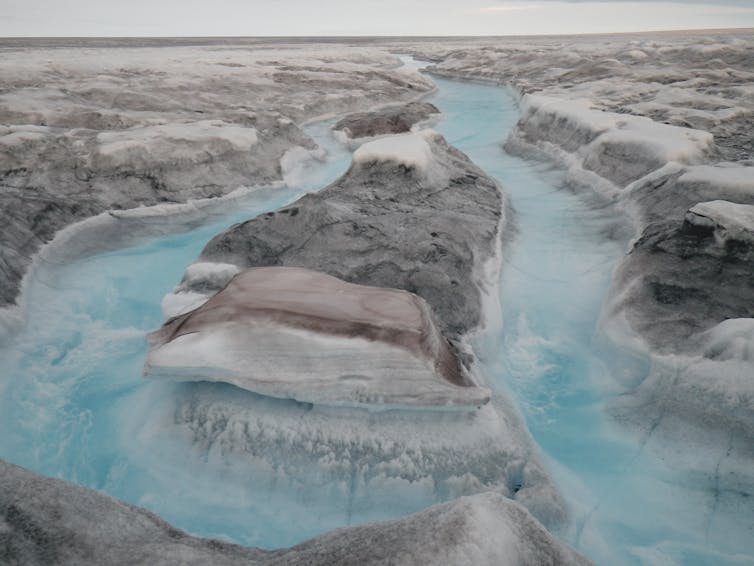
A highly darkened surface of the Greenland ice sheet, rich in algae and incised with rivers of meltwater.
Arwyn Edwards, Author provided
As we warm our climate, the rate of water flowing from this reservoir increases, with each degree Celsius added to global temperatures opening the drainage valve even wider. Feedback processes such as biological darkening have the potential to multiply the number of drainage valves that are open, hastening dramatically the rate at which sea levels rise.
To monitor this effect, every day Karen Cameron, the leader of our camp this summer, walks to undisturbed patches of ice carrying a £100,000 backpack which contains a spectrometer to measure the darkness of the ice, capturing how it absorbs the solar energy that causes melting. The glaciologists are desperate for ground truth, and their models need data.
Up to this point, none of their predictions of how the Greenland ice sheet would respond to our warming climate have included biological darkening. Even if the effect were modest, it could still topple the ice sheet from a predictable, straightline response to climate warming.
All the time we are in Greenland, the only lifeforms we encounter are the flies that hatch from the fresh fruit and peppers in our food rations. These and the few types of glacier algae and several hundred kinds of bacteria that are biologically darkening the ice: a living scum scarring the surface of the ice sheet.
My work focuses on how these tiny organisms adapt to their icy habitat, but the implications of their behaviour are now of global concern. A filmmaker at the camp is weaving a thread between the ice melt in Greenland and its consequences for people living in coastal communities all over the world – from villages near my home on the west coast of Wales, to huge metropolises like Manhattan, Amsterdam and Mumbai, and even entire low-lying island nations in the Pacific.
As smaller glaciers fade, and the larger ice sheets of Greenland and Antarctica start to respond with full force to our warming climate, it is these communities, capitals and countries that will bear the brunt of the flooding, inundation and erosion that comes with rising sea levels.
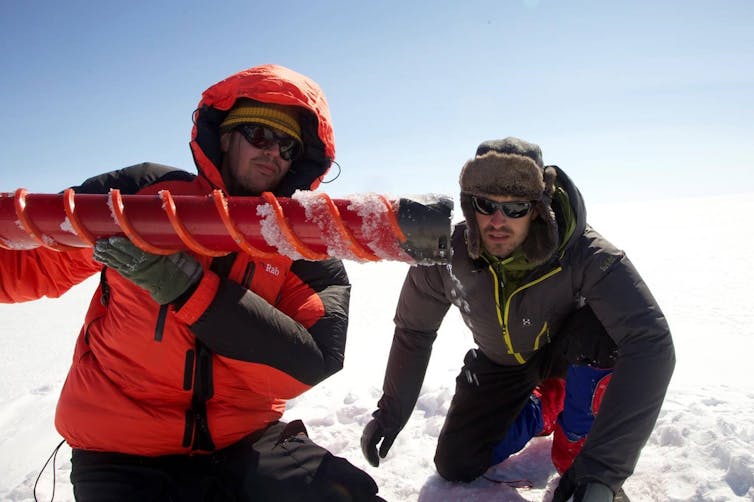
The author (left) and Joseph Cook high on the Greenland ice sheet, meltwater dripping from their ice corer.
Sara Penrhyn Jones, Author provided
Before heading home, our helicopter takes us on a detour, high over the ice sheet. We fly over the brown-black-purple algae to brighter, higher elevations where the palette shrinks to the blue and white of water and ice, then snow and sky. Greenland makes its own weather and, in these higher elevations, we expect the ice to be frozen all year round. When we land and begin to collect snow samples and a small ice core, however, we find we are digging into slush. The ice has started to melt up here, too.
We heave up our ice corer, and meltwater dribbles out from its bottom. In periods of extreme warming, much of the surface of the ice sheet can experience melting episodes, disturbing the slumbering microbes stored within the otherwise permanently frozen surface. It’s a sobering moment for us all.
Flying back to camp, I watch the streams become rivers and lakes as we head back over the dark zone, where melt and microbes dominate the icescape. I contemplate how much water, once locked in the ice, will become free to flow into the sea and into millions of homes by the end of the century.
Popping a pingo
The frozen lands of eight nations encircle the Arctic. Their soils store vast quantities of carbon: a third of the planet’s entire quantity of soil carbon resides in this frozen ground.
The carbon is a legacy of soils formed in past climates and preserved for millennia. However, human-induced climate change is reheating this leftover carbon, providing a luxuriant food source for microbes resident within the tundra, which then emit it as greenhouse gases.
This is known as the permafrost carbon feedback loop. When even modest quantities of this vast carbon store reach the atmosphere, warming accelerates – resulting in faster thawing of the tundra and the release of yet more greenhouse gases.
Furthermore, not all greenhouse gases are equal in their impact. While carbon dioxide is relatively abundant and stable for centuries in the atmosphere, methane is less abundant and shorter-lived, but remarkably powerful as a greenhouse gas – nearly 30 times more damaging to the climate than carbon dioxide, for the same volume.
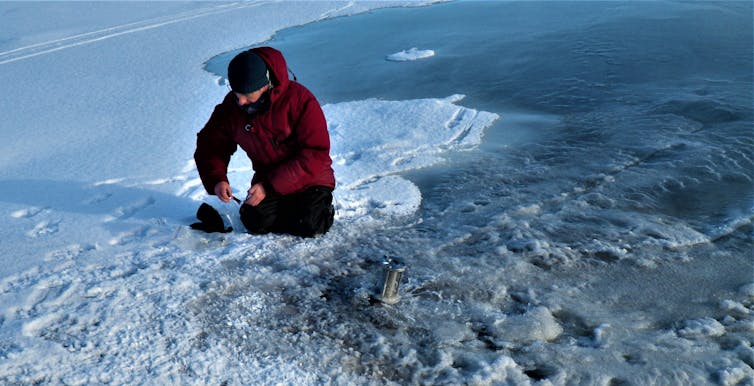
Andy Hodson sampling methane from a freshly ‘popped’ pingo.
Arwyn Edwards, Author provided
For more than three decades, Andy Hodson has worked at the frontier where microbes, carbon and the Arctic landscape meet. In 2018, we join him on a brisk spring day in Svalbard. It’s -26°C but the snowmobile commute is thankfully brief – then we work quickly against the cold.
Hodson’s plan is to “pop” one of the many pingos that populate the floor of this wide open valley. Think of pingos as the acne of the Arctic: they form as permafrost compresses unfrozen wet sediments, erupting as small hills blistering the skin of the tundra.
The story of these microbes’ lives is complicated. They only live beyond the reach of oxygen – where oxygen is more prevalent, methane-consuming microbes thrive instead, quenching the belches of methane from below. Similarly, should mineral sources of iron or sulphide be nearby, then microbes that use them outcompete the methanogens.
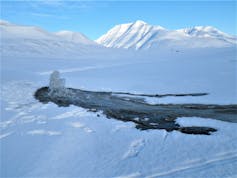
A popped pingo discharging supercooled water rich in methane.
Arwyn Edwards, Author provided
It all adds up to one of the greatest uncertainties for our civilisation: the extent and composition of greenhouse gases escaping from Arctic lands. Estimates of the economic impacts from this permafrost carbon feedback tally in the tens of trillions of dollars to the global economy. We know it is bad news, but exactly how bad depends on the microbes in their microscopic mosaic.
Hodson’s field work shows that, during the Arctic winter, this pingo is probably the only source of methane in the immediate area, its chimney enabling the gas to escape from the depths of the ice before methane-consuming microbes can catch it. Annually, tens of kilograms of methane and more than a ton of carbon dioxide will escape from this pingo alone - one of more than 10,000 scattered across the Arctic, in addition to its other methane-producing hotspots.
A near-perfect ecosystem
Arctic lands are a patchwork of permafrost carbon feedbacks, and our future depends on the uncertain fate of the microbes within.
While the ice melt enhances the growth of microbes in the short term, if it continues to the point of erasing habitats then the microbes will be lost with them. We recognise this danger for polar bears and walruses, but not the invisible biodiversity of the Arctic. Small does not mean insignificant though.
To appreciate this, we can head back to the dark zone on Greenland’s ice sheet and join Joseph Cook during our summer 2014 field season. He’s lying on a mat improvised from a bath towel and a binbag wrapped in duct tape, peering into a dark, pothole-like depression in the ice. It’s a cryoconite hole, and millions of them are dotted over the edges of the ice sheet. Where pingos contribute to climate warming by emitting methane, cryoconite is a good sink of greenhouse gases, but this creates its own problems.
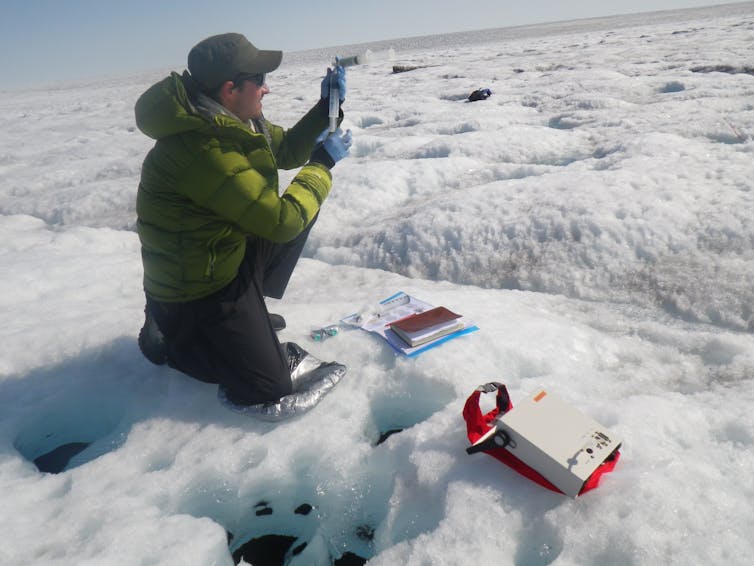
Joseph Cook measuring the carbon cycling activities of Greenland’s cryoconite holes.
Arwyn Edwards, Author provided
The earliest estimate of its ability to store carbon dioxide from the air on the ice surface of the world’s glaciers exceeded Finland’s total carbon emissions in the same year. Every cryoconite hole is a near-perfect ecosystem – with a singular flaw. Its inhabitants must melt ice to live. But the very act of melting the ice hastens the demise of their glacier habitat.
Despite being found in some of the harshest locations on Earth, cryoconite is home for thousands of different types of bacteria (including the all-important photosynthetic cyanobacteria), fungi, and protozoa. Even tardigrades thrive in cryoconite.
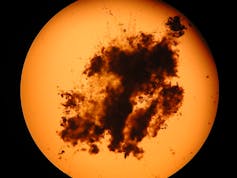
Microscope image of a cryoconite granule, showing biological darkening and cyanobacteria growing through it.
Arwyn Edwards, Author provided
Cook is professionally besotted with the perfection of this near-frozen “microscopic rainforest”. Its inhabitants are shielded and nourished at just the right depth and in the right shape for a busy ecosystem to be engineered by the interaction of sunlight with cyanobacteria, dust and ice to the benefit of all its inhabitants. The cyanobacteria use sunshine to capture carbon dioxide from the air and convert it into the slimy cement that builds each granule of cryoconite
However, with vast numbers of cryoconite holes dotted across the ice surface, “swarms” of these holes help shape and darken the ice surface. This in turn influences the melting rate, as the surface is sculpted under the sun of 24-hour daylight.
Writing in the scientific journal Nature in 1883, Swedish polar explorer Adolf Erik Nordenskjöld, who discovered cryoconite, thanked the organisms within cryoconite for melting away the ancient ice that once covered Norway and Sweden:
In spite of their insignificance, [they] play a very important part in nature’s economy, from the fact that their dark colour far more readily absorbs the Sun’s heat than the bluish-white ice, and thereby they contribute to the destruction of the ice sheet, and prevent its extension. Undoubtedly we have, in no small degree, to thank these organisms for the melting away of the layer of ice which once covered the Scandinavian peninsula.
Taking DNA analysis to strange new places
We return to Greenland in winter 2018 to explore cryoconite’s singular flaw. Cook and I are joined by Melanie Hay, then a PhD student in Arctic bioinformatics.
Hay and I are taking DNA analysis to strange new places to learn more about the evolution and biology of cryoconite. Powerful advances in genomics are changing our view of the microbial world, but large DNA-sequencing instruments fare best in sophisticated labs.
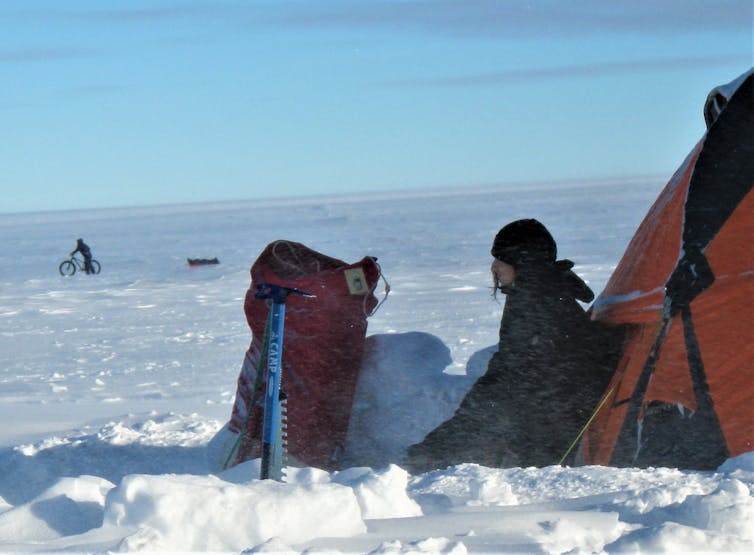
Melanie Hay camping and sampling on the Greenland ice sheet.
Arwyn Edwards, Author provided
Instead, we are using a stapler-sized nanopore sequencer hooked up to the USB port of a winterised laptop. Outside the tent, it is –20°C – but the DNA sequencer must run at body temperature. The only sustainable source of warmth is body heat, so I have snuggled up with the sequencer in my sleeping bag every night and in my clothes all day.
That evening, we are caught in a storm of hurricane force. Becoming disorientated while moving between tents would be lethal, so we crawl in a human chain through the whiteout to our sleeping tents. Hay reaches her tent but Cook’s is lost, so we squeeze into my one-person tent. Somehow I sleep soundly, while Cook is exposed to the full force of the night’s terror.
In the morning, we excavate Hay, whose snow-laden tent had collapsed in the night. The sequencing is complete, but storm damage to our generator means the camp is losing power, so she must work quickly. She identifies the cyanobacteria building the cryoconite – it’s a short list dominated by one species: Phormidesmis priestleyi.
This species, found in cryoconite throughout the Arctic, seems to be the ecosystem engineer of cryoconite – a microscopic beaver building a dam of dust. But the flaw is the darkness of the near-perfect cryoconite ecosystems it creates. Like the neighbouring glacier algae we met earlier, Phormidesmis priestleyi is biologically darkening Arctic ice, and eventually hastening the demise of the thousands of different types of organism contained in cryoconite holes.
And so, this work shows us ever more clearly that the loss of the planet’s glaciers is as much a component of the global biodiversity crisis as it is a headline impact of climate change.
Last line of defence against antibiotic resistance
The loss of the Arctic’s microbial biodiversity matters in other ways too. Hay and Aliyah Debbonaire are both reformed biomedical scientists seeking cures from the Arctic in the form of new antibiotics. In the summer of 2018, we are in Svalbard looking for clues.
The world is running out of effective antibiotics, and the Arctic’s frontiers may be our last line of defence in this antibiotic resistance crisis. Countless species of microbes have evolved to live within its harsh habitats using all the tricks in the book, including making antibiotics as chemical weapons to kill off competitors. This means they may be sources of new antibiotics.
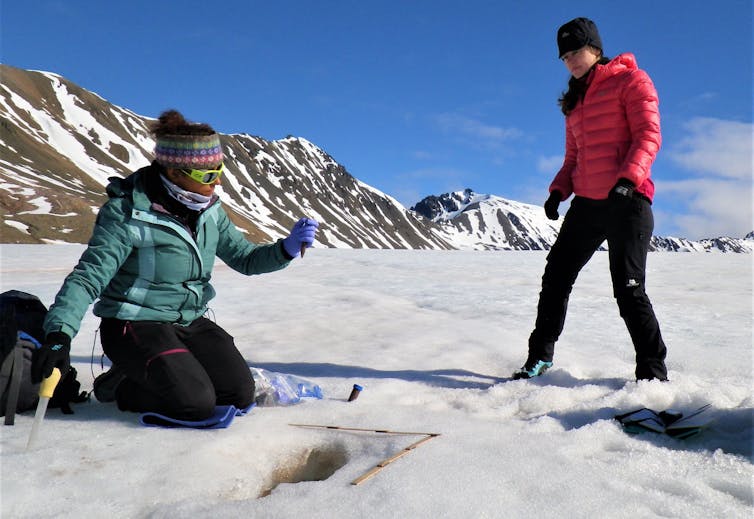
Aliyah Debbonaire (left) and Melanie Hay sampling a cryoconite hole.
Arwyn Edwards, Author provided
And this is not their only application. From cheeses to eco-friendly biological washing powders, entire shopping aisles of products have been derived from cold-adapted microbes. As climate warming threatens to disrupt entire Arctic habitats, our opportunity to use, learn from, and protect this biodiversity may be lost forever.
As our tiny plane returns to the nearest town, Longyearbyen, we fly low over the Svalbard Global Seed Vault, which contains the fruits of more than 12,000 years of agriculture in the form of seeds from a million different varieties of crop. Nearby, a similar facility inside a disused coal mine stores essential computer programmes on microfilm – the ultimate backup for our data-addicted world.
Within a snowy kilometre, you can walk between the the alpha and omega of human innovation in civilisation. Both facilities have chosen the fastest-warming town on the planet as the safest place to store these treasures of humanity. Yet no such facility is dedicated to the microbial biodiversity of the Arctic, despite its critical importance to the future of the world’s biotech and medical sectors.
Instead, it falls to microbiologists such as Debbonaire, racing against time to identify, nurture and screen the microbes of the melting Arctic. Her painstaking work accumulates towers of Petri dishes, each a temporary refuge for a different Arctic microbe.
Eventually, they will be stored in ultra-freezers in laboratories scattered across the world. Such work is unglamorous to funders, so it is done piecemeal on the edges of other projects. Yet it represents our only attempt to save the microbes of the Arctic.
The battle is lost
Most of all, the Arctic matters because it is the fastest-warming part of the planet, and its microbes are responding first. What happens there carries implications for everyone. It is the harbinger of change for everywhere.
Another Arctic microbiologist could strike plangent notes regarding permafrost or sea ice, but as an ecologist of glaciers I am drawn to glacial ice.
Over the first fifth of this century, Earth’s glaciers have discharged some ten quadrillion (ten to the power 25) tablespoons of melt a year – and within each tablespoon, the tens of thousands of bacteria and viruses that were once stored within that ice.
What’s to come is sadly predictable. Even the most modest warming scenario of 1.5°C above the pre-industrial era will lead to the extinction of at least half the Earth’s 200,000 glaciers by the end of the century.
Depending on the urgency and effectiveness of our actions as a civilisation, this century could also represent the “peak melt” in our history. Yet the battle to save many of these precious icy habitats is already lost. Instead, for scientists like me, our field work is now largely a question of documenting these “crime scenes” – so at least the knowledge of life within ice can be preserved, before it melts away forever.

For you: more from our Insights series:
‘Too afraid to have kids’ – how BirthStrike for Climate lost control of its political message
Climate scientists: concept of net zero is a dangerous trap
Beyond GDP: changing how we measure progress is key to tackling a world in crisis – three leading experts
Arwyn Edwards, Reader in Biology, Department of Life Sciences, Aberystwyth University
This article is republished from The Conversation under a Creative Commons license. Read the original article.
The Arctic’s climate is warming at least four times faster than the global average, causing irrevocable changes to this vast landscape and precarious ecosystem – from the anticipated extinction of polar bears to the appearance of killer whales in ever-greater numbers. A new study suggests the Arctic Ocean could be ice-free in summer as soon as the 2030s – around a decade earlier than previously predicted.

A new Arctic sea ice map compares the 30-year average with recent ten-year averages.
British Antarctic Survey
But to properly understand the pace and force of what’s to come, we should instead focus on organisms too small to be seen with the naked eye. These single-celled microbes are both the watchkeepers and arch-agitators of the Arctic’s demise.
Scientists like me who study them have become forensic pathologists, processing crime scenes in our Arctic field sites. We don the same white anti-contamination suits, photograph each sampling site, and bag our samples for DNA analysis. In some areas, red-coloured microbes even create an effect known as “blood snow”.
In this complex criminal investigation, however, the invisible witnesses are also responsible for the damage being done. Microbes testify to the vulnerability of their Arctic habitats to the changes that humans have caused. But they also create powerful climate feedback loops that are doing ever-more damage both to the Arctic, and the planet as a whole.
Zipping headlong into icy oblivion
My first visit to the Arctic was also nearly my last. As a PhD student in my early 20s in 2006, I had set out with colleagues to sample microbes growing on a glacier in the Norwegian archipelago of Svalbard – the planet’s northernmost year-round settlement, about 760 miles from the North Pole.
Our treacherous commute took us high above the glacier, traversing an icy scree slope to approach its flank before crossing a river at the ice’s margin. It was a route we had navigated recently – yet this day I mis-stepped. Time slowed as I slid towards the stream swollen with ice melt, my axe bouncing uselessly off the glassy ice. I was zipping headlong into icy oblivion.
In that near-death calm, two things bothered me. The water would carry me deep into the glacier, so it would be decades before my remains were returned to my family. And the ear-worm of that field season meant I would die to the theme tune to Indiana Jones.
This article is part of Conversation InsightsThe Insights team generates long-form journalism derived from interdisciplinary research. The team is working with academics from different backgrounds who have been engaged in projects aimed at tackling societal and scientific challenges.
Thankfully, the scree slowed my slide – I lived and learned, quickly, that dead scientists don’t get to write up their papers. And I’m still learning about the tiny organisms that populate every habitat there: from seawater in the Arctic Ocean to ice crystals buried deep in the Greenland ice sheet.
These micro-managers of all manner of planetary processes are acutely sensitive to the temperatures of their habitats. The slightest change above freezing can transform an Arctic landscape from a frozen waste devoid of liquid water to one where microbes get busy reproducing in nutrient-rich water, transforming themselves in ways that further amplify the effects of climate warming.
The Svalbard region is now warming seven times faster than the global average. While much of the world continues its efforts to limit global warming to 1.5°C above pre-industrial levels, in the Arctic, that battle was lost long ago.
Joseph Cook’s film on the microbes that inhabit the Greenland ice sheet.
Decades ahead of us all
It’s 2011, and Nozomu Takeuchi is visiting Svalbard from Japan. It has been a difficult year back home, following the earthquake, tsunami and Fukushima nuclear incident, but Nozomu – a glacier ecologist and professor at Chiba University – is unrelenting in his quest to measure the effects of climate change.
Just hours after he stepped off a plane in the August midnight sun at Longyearbyen airport, we are marching up the nearest glacier. Above us, snow-capped mountain sides loom out of the swirling mist.
Since the 1990s, Nozomu has been collecting samples and measurements from glaciers all over the world. When we reach our goal near the snowline, he opens his rucksack to reveal a bento box full of sampling kit – stainless steel scoops, test tubes, sample bags, all arranged for efficiency. As he scurries around with practised efficiency, I think of offering help but fear I would only slow him down.

Nozomu Takeuchi measuring the biological darkening of a Svalbard glacier in 2011.
Arwyn Edwards, Author provided
In truth, Nozomu is decades ahead of us all. Years ago, he made the link between the future of life and the death of ice, and these melting Svalbard glaciers are adding yet more points to his graphs.
Just as we apply oodles of factor 50 to protect ourselves from the Sun, so the billions of microbes sandwiched between the sky and surface of the glacier protect themselves by accumulating sunscreen-like pigments. And if enough of these pigments rest in one place under the Sun, this area of “biological darkening” absorbs the heat of the Sun much more effectively than reflective white snow and ice – so it melts faster.
Nozomu scoops up some of the so-called blood snow, heavily laden with algae. Under the microscope, their cells are indeed reminiscent of red blood cells. But rather than haemoglobin, these cells are laden with carotenoids – pigments also found in vegetables that protect the algae from overheating. Other patches of the glacier are verdant green, rich in algae that are busy photosynthesising light into chemical energy in this 24-hour daylight world.

The author with a sample of ‘blood snow’, collected from a glacier surface.
Arwyn Edwards, Author provided
Further down the glacier, the professor crushes some “dirty” ice into a bag. A different kind of algae lives here that, depending on your point-of-view, is either black, brown or purple (perhaps it depends on the tint of your sunglasses). The pigment created is like the compounds that colour tea, and the algae keep it in layers like parasols above the photosynthetic factories within their cells – ensuring they have just enough sunlight to photosynthesise, but not enough to burn.
Open Google Earth and as you zoom in on the Arctic, you may spot the large dark stripe that scars the western margin of the Greenland ice sheet. This is the “dark zone”, but it’s not caused by dark dust or soot. It’s alive, laden with algae – and it has been darkening, and growing, as Greenland warms.
Between 2000 and 2014, the dark zone’s area grew by 14%. At 279,075 km² in 2012, it was already more than twice the size of England than bare ice.
Next morning, I am woken by the smell of chemicals, having slept beneath a coffee table. Nozomu is busy processing his samples: bags of melting ice pinned to a clothesline by bulldog clips. They resemble bunting around the crowded room, but this is no time for celebration. The tint of each bag adds a measurement which quantifies the link between these algae, their pigments, and the death of their icy home.
The case becomes urgent
By the summer of 2014, glaciologists all over the world have started to listen to the warnings of pioneering ecologists such as Nozomu. The glaciers are dying even as life blossoms on their darkening surfaces. The case has become urgent.
I am in a helicopter, flying with colleagues to a camp in the dark zone on the Greenland ice sheet – the largest mass of glacial ice in the northern hemisphere. Covering 1.7 million km², its ice holds the equivalent of the water required to raise global sea levels by 7.7 metres.

A highly darkened surface of the Greenland ice sheet, rich in algae and incised with rivers of meltwater.
Arwyn Edwards, Author provided
As we warm our climate, the rate of water flowing from this reservoir increases, with each degree Celsius added to global temperatures opening the drainage valve even wider. Feedback processes such as biological darkening have the potential to multiply the number of drainage valves that are open, hastening dramatically the rate at which sea levels rise.
To monitor this effect, every day Karen Cameron, the leader of our camp this summer, walks to undisturbed patches of ice carrying a £100,000 backpack which contains a spectrometer to measure the darkness of the ice, capturing how it absorbs the solar energy that causes melting. The glaciologists are desperate for ground truth, and their models need data.
Up to this point, none of their predictions of how the Greenland ice sheet would respond to our warming climate have included biological darkening. Even if the effect were modest, it could still topple the ice sheet from a predictable, straightline response to climate warming.
All the time we are in Greenland, the only lifeforms we encounter are the flies that hatch from the fresh fruit and peppers in our food rations. These and the few types of glacier algae and several hundred kinds of bacteria that are biologically darkening the ice: a living scum scarring the surface of the ice sheet.
My work focuses on how these tiny organisms adapt to their icy habitat, but the implications of their behaviour are now of global concern. A filmmaker at the camp is weaving a thread between the ice melt in Greenland and its consequences for people living in coastal communities all over the world – from villages near my home on the west coast of Wales, to huge metropolises like Manhattan, Amsterdam and Mumbai, and even entire low-lying island nations in the Pacific.
As smaller glaciers fade, and the larger ice sheets of Greenland and Antarctica start to respond with full force to our warming climate, it is these communities, capitals and countries that will bear the brunt of the flooding, inundation and erosion that comes with rising sea levels.

The author (left) and Joseph Cook high on the Greenland ice sheet, meltwater dripping from their ice corer.
Sara Penrhyn Jones, Author provided
Before heading home, our helicopter takes us on a detour, high over the ice sheet. We fly over the brown-black-purple algae to brighter, higher elevations where the palette shrinks to the blue and white of water and ice, then snow and sky. Greenland makes its own weather and, in these higher elevations, we expect the ice to be frozen all year round. When we land and begin to collect snow samples and a small ice core, however, we find we are digging into slush. The ice has started to melt up here, too.
We heave up our ice corer, and meltwater dribbles out from its bottom. In periods of extreme warming, much of the surface of the ice sheet can experience melting episodes, disturbing the slumbering microbes stored within the otherwise permanently frozen surface. It’s a sobering moment for us all.
Flying back to camp, I watch the streams become rivers and lakes as we head back over the dark zone, where melt and microbes dominate the icescape. I contemplate how much water, once locked in the ice, will become free to flow into the sea and into millions of homes by the end of the century.
Popping a pingo
The frozen lands of eight nations encircle the Arctic. Their soils store vast quantities of carbon: a third of the planet’s entire quantity of soil carbon resides in this frozen ground.
The carbon is a legacy of soils formed in past climates and preserved for millennia. However, human-induced climate change is reheating this leftover carbon, providing a luxuriant food source for microbes resident within the tundra, which then emit it as greenhouse gases.
This is known as the permafrost carbon feedback loop. When even modest quantities of this vast carbon store reach the atmosphere, warming accelerates – resulting in faster thawing of the tundra and the release of yet more greenhouse gases.
Furthermore, not all greenhouse gases are equal in their impact. While carbon dioxide is relatively abundant and stable for centuries in the atmosphere, methane is less abundant and shorter-lived, but remarkably powerful as a greenhouse gas – nearly 30 times more damaging to the climate than carbon dioxide, for the same volume.

Andy Hodson sampling methane from a freshly ‘popped’ pingo.
Arwyn Edwards, Author provided
For more than three decades, Andy Hodson has worked at the frontier where microbes, carbon and the Arctic landscape meet. In 2018, we join him on a brisk spring day in Svalbard. It’s -26°C but the snowmobile commute is thankfully brief – then we work quickly against the cold.
Hodson’s plan is to “pop” one of the many pingos that populate the floor of this wide open valley. Think of pingos as the acne of the Arctic: they form as permafrost compresses unfrozen wet sediments, erupting as small hills blistering the skin of the tundra.
The story of these microbes’ lives is complicated. They only live beyond the reach of oxygen – where oxygen is more prevalent, methane-consuming microbes thrive instead, quenching the belches of methane from below. Similarly, should mineral sources of iron or sulphide be nearby, then microbes that use them outcompete the methanogens.

A popped pingo discharging supercooled water rich in methane.
Arwyn Edwards, Author provided
It all adds up to one of the greatest uncertainties for our civilisation: the extent and composition of greenhouse gases escaping from Arctic lands. Estimates of the economic impacts from this permafrost carbon feedback tally in the tens of trillions of dollars to the global economy. We know it is bad news, but exactly how bad depends on the microbes in their microscopic mosaic.
Hodson’s field work shows that, during the Arctic winter, this pingo is probably the only source of methane in the immediate area, its chimney enabling the gas to escape from the depths of the ice before methane-consuming microbes can catch it. Annually, tens of kilograms of methane and more than a ton of carbon dioxide will escape from this pingo alone - one of more than 10,000 scattered across the Arctic, in addition to its other methane-producing hotspots.
A near-perfect ecosystem
Arctic lands are a patchwork of permafrost carbon feedbacks, and our future depends on the uncertain fate of the microbes within.
While the ice melt enhances the growth of microbes in the short term, if it continues to the point of erasing habitats then the microbes will be lost with them. We recognise this danger for polar bears and walruses, but not the invisible biodiversity of the Arctic. Small does not mean insignificant though.
To appreciate this, we can head back to the dark zone on Greenland’s ice sheet and join Joseph Cook during our summer 2014 field season. He’s lying on a mat improvised from a bath towel and a binbag wrapped in duct tape, peering into a dark, pothole-like depression in the ice. It’s a cryoconite hole, and millions of them are dotted over the edges of the ice sheet. Where pingos contribute to climate warming by emitting methane, cryoconite is a good sink of greenhouse gases, but this creates its own problems.

Joseph Cook measuring the carbon cycling activities of Greenland’s cryoconite holes.
Arwyn Edwards, Author provided
The earliest estimate of its ability to store carbon dioxide from the air on the ice surface of the world’s glaciers exceeded Finland’s total carbon emissions in the same year. Every cryoconite hole is a near-perfect ecosystem – with a singular flaw. Its inhabitants must melt ice to live. But the very act of melting the ice hastens the demise of their glacier habitat.
Despite being found in some of the harshest locations on Earth, cryoconite is home for thousands of different types of bacteria (including the all-important photosynthetic cyanobacteria), fungi, and protozoa. Even tardigrades thrive in cryoconite.

Microscope image of a cryoconite granule, showing biological darkening and cyanobacteria growing through it.
Arwyn Edwards, Author provided
Cook is professionally besotted with the perfection of this near-frozen “microscopic rainforest”. Its inhabitants are shielded and nourished at just the right depth and in the right shape for a busy ecosystem to be engineered by the interaction of sunlight with cyanobacteria, dust and ice to the benefit of all its inhabitants. The cyanobacteria use sunshine to capture carbon dioxide from the air and convert it into the slimy cement that builds each granule of cryoconite
However, with vast numbers of cryoconite holes dotted across the ice surface, “swarms” of these holes help shape and darken the ice surface. This in turn influences the melting rate, as the surface is sculpted under the sun of 24-hour daylight.
Writing in the scientific journal Nature in 1883, Swedish polar explorer Adolf Erik Nordenskjöld, who discovered cryoconite, thanked the organisms within cryoconite for melting away the ancient ice that once covered Norway and Sweden:
In spite of their insignificance, [they] play a very important part in nature’s economy, from the fact that their dark colour far more readily absorbs the Sun’s heat than the bluish-white ice, and thereby they contribute to the destruction of the ice sheet, and prevent its extension. Undoubtedly we have, in no small degree, to thank these organisms for the melting away of the layer of ice which once covered the Scandinavian peninsula.
Taking DNA analysis to strange new places
We return to Greenland in winter 2018 to explore cryoconite’s singular flaw. Cook and I are joined by Melanie Hay, then a PhD student in Arctic bioinformatics.
Hay and I are taking DNA analysis to strange new places to learn more about the evolution and biology of cryoconite. Powerful advances in genomics are changing our view of the microbial world, but large DNA-sequencing instruments fare best in sophisticated labs.

Melanie Hay camping and sampling on the Greenland ice sheet.
Arwyn Edwards, Author provided
Instead, we are using a stapler-sized nanopore sequencer hooked up to the USB port of a winterised laptop. Outside the tent, it is –20°C – but the DNA sequencer must run at body temperature. The only sustainable source of warmth is body heat, so I have snuggled up with the sequencer in my sleeping bag every night and in my clothes all day.
That evening, we are caught in a storm of hurricane force. Becoming disorientated while moving between tents would be lethal, so we crawl in a human chain through the whiteout to our sleeping tents. Hay reaches her tent but Cook’s is lost, so we squeeze into my one-person tent. Somehow I sleep soundly, while Cook is exposed to the full force of the night’s terror.
In the morning, we excavate Hay, whose snow-laden tent had collapsed in the night. The sequencing is complete, but storm damage to our generator means the camp is losing power, so she must work quickly. She identifies the cyanobacteria building the cryoconite – it’s a short list dominated by one species: Phormidesmis priestleyi.
This species, found in cryoconite throughout the Arctic, seems to be the ecosystem engineer of cryoconite – a microscopic beaver building a dam of dust. But the flaw is the darkness of the near-perfect cryoconite ecosystems it creates. Like the neighbouring glacier algae we met earlier, Phormidesmis priestleyi is biologically darkening Arctic ice, and eventually hastening the demise of the thousands of different types of organism contained in cryoconite holes.
And so, this work shows us ever more clearly that the loss of the planet’s glaciers is as much a component of the global biodiversity crisis as it is a headline impact of climate change.
Last line of defence against antibiotic resistance
The loss of the Arctic’s microbial biodiversity matters in other ways too. Hay and Aliyah Debbonaire are both reformed biomedical scientists seeking cures from the Arctic in the form of new antibiotics. In the summer of 2018, we are in Svalbard looking for clues.
The world is running out of effective antibiotics, and the Arctic’s frontiers may be our last line of defence in this antibiotic resistance crisis. Countless species of microbes have evolved to live within its harsh habitats using all the tricks in the book, including making antibiotics as chemical weapons to kill off competitors. This means they may be sources of new antibiotics.

Aliyah Debbonaire (left) and Melanie Hay sampling a cryoconite hole.
Arwyn Edwards, Author provided
And this is not their only application. From cheeses to eco-friendly biological washing powders, entire shopping aisles of products have been derived from cold-adapted microbes. As climate warming threatens to disrupt entire Arctic habitats, our opportunity to use, learn from, and protect this biodiversity may be lost forever.
As our tiny plane returns to the nearest town, Longyearbyen, we fly low over the Svalbard Global Seed Vault, which contains the fruits of more than 12,000 years of agriculture in the form of seeds from a million different varieties of crop. Nearby, a similar facility inside a disused coal mine stores essential computer programmes on microfilm – the ultimate backup for our data-addicted world.
Within a snowy kilometre, you can walk between the the alpha and omega of human innovation in civilisation. Both facilities have chosen the fastest-warming town on the planet as the safest place to store these treasures of humanity. Yet no such facility is dedicated to the microbial biodiversity of the Arctic, despite its critical importance to the future of the world’s biotech and medical sectors.
Instead, it falls to microbiologists such as Debbonaire, racing against time to identify, nurture and screen the microbes of the melting Arctic. Her painstaking work accumulates towers of Petri dishes, each a temporary refuge for a different Arctic microbe.
Eventually, they will be stored in ultra-freezers in laboratories scattered across the world. Such work is unglamorous to funders, so it is done piecemeal on the edges of other projects. Yet it represents our only attempt to save the microbes of the Arctic.
The battle is lost
Most of all, the Arctic matters because it is the fastest-warming part of the planet, and its microbes are responding first. What happens there carries implications for everyone. It is the harbinger of change for everywhere.
Another Arctic microbiologist could strike plangent notes regarding permafrost or sea ice, but as an ecologist of glaciers I am drawn to glacial ice.
Over the first fifth of this century, Earth’s glaciers have discharged some ten quadrillion (ten to the power 25) tablespoons of melt a year – and within each tablespoon, the tens of thousands of bacteria and viruses that were once stored within that ice.
What’s to come is sadly predictable. Even the most modest warming scenario of 1.5°C above the pre-industrial era will lead to the extinction of at least half the Earth’s 200,000 glaciers by the end of the century.
Depending on the urgency and effectiveness of our actions as a civilisation, this century could also represent the “peak melt” in our history. Yet the battle to save many of these precious icy habitats is already lost. Instead, for scientists like me, our field work is now largely a question of documenting these “crime scenes” – so at least the knowledge of life within ice can be preserved, before it melts away forever.

For you: more from our Insights series:
‘Too afraid to have kids’ – how BirthStrike for Climate lost control of its political message
Climate scientists: concept of net zero is a dangerous trap
Beyond GDP: changing how we measure progress is key to tackling a world in crisis – three leading experts
Arwyn Edwards, Reader in Biology, Department of Life Sciences, Aberystwyth University
This article is republished from The Conversation under a Creative Commons license. Read the original article.

No comments:
Post a Comment